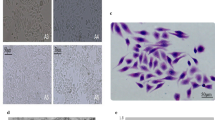Abstract
A new cell line designated Nur-1 has been established from human endometrioid adenocarcinoma, Grade 1, pT1a, PN1 (3/24), Stage IIIc (International Federation of Gynecology and Obstetrics/Union for International Cancer Control (FIGO/UICC TNM Classification of Malignant Tumours, 7th ed.). Cytological findings of Nur-1 cells reveal anaplastic and pleomorphic features such as anisonucleosis, nucleolar pleomorphism, and piling-up tendency in cellular arrangement. Distribution of the chromosome number is found at the hyperploid range, and the apparent marker chromosome has not been identified. The original tumor and graft of the Nur-1 cell line had a large amount of estrogen receptors and progesterone receptors, as revealed by immunohistochemistry. The cytokeratin pattern of the tumor was positive for cytokeratin-7 and negative for cytokeratin-20. However, a few cells were positive for cytokeratin-20 in the original tumor. Nur-1 cells express mRNA of estrogen receptors and progesterone receptors, cytokeratin-7, and cytokeratin-20 at 105 passages. These findings are consistent with the cytokeratin pattern of endometrial glandular cells. The cells make contact with each other via interdigitation and desmosomes. They possess bundles of microtubules and tonofilaments and many free ribosomes. Some cells have various sizes of phagosomes. The Nur-1 cell line exceeded 102 passages in 5 years, and multiplication of the cells is stable. The modal number of the Nur-1 cell line is 91–92 (56 %). The Nur-1 cells develop well-differentiated adenocarcinoma in tumors sustained in nude mice that resemble the original tumors.










Similar content being viewed by others
References
Kuramoto H, Tamura S, Notake Y. Establishment of a cell line of human endometrial adenocarcinoma in vitro. Am J Obstet Gynecol. 1972;114(8):1012–9.
Kuramoto H, Marnano M, Nishida M, Taguchi A, Jobo T, Suzuki M, Osanai K. Establishment of a new human endometrial carcinoma cell line derived from ascites. Acta Obstet Gynaecol Jpn. 1976;28:1405–6.
Nishida M, Kasahara K, Kaneko M, Iwasaki H, Hayashi K. Establishment of a new human endometrial adenocarcinoma cell line, Ishikawa cells, containing estrogen and progesterone receptors. Acta Obstet Gynecol Jpn. 1985;37:1103–11.
Kim JW, Lee CG, Choi SK, Kim JH, Kim TE, Lee JM, Rha JG, Namkoong SE. Establishment and characterization of a highly tumorigenic human diploid endometrial cancer cell line. Cancer Genet Cytogenet. 1997;99(1):1–10.
Gey GO, Coffman WD, Kubicek MT. Tissue culture studies of the pror liferative capacity of cervical carcinoma and normal epithelium. Cancer Res. 1952;12:264.
Roland AP, George OG. The establishment of a cell line of human hormone-synthesizing trophoblastic cells in vitro. Cancer Res. 1968;28:1231–6.
Resa WV. A human tumour with identifiable cells as evidence for the mutation theory. Br J Cancer. 1962;16:616–8. doi:10.1038/bjc.1962.72.
Marion CB. A chromosome study of seven near-diploid carcinomas of the corpus uteri FREE. Br J Cancer. 1968;22:683–95. doi:10.1038/bjc.1968.81.
Kelly RM, Baker WH. The effect of 17 alpha-hydroxyprogesterone caproate on metastatic endometrial cancer. Natl Cancer Inst Monogr. 1960;9:235.
Wharton RQ, Jonas SK, Glover C, Khan ZA, Klokouzas A, Quinn H, Henry M, Allen-Mersh TG. lncreased detection of circulating tumor cells in the blood of colorectal carcinoma patients using two reverse transcription-PCR assays and multiple blood samples. Clin Cancer Res. 1999;5:4158–63.
Won YS, Lee SJ, Yeo SG, Park DC. Effects of female sex hormones on clusterin expression and paclitaxel resistance in endometrial cancer cell lines. Int J Med Sci. 2012;9:86–92.
Acknowledgments
The authors are indebted to Miss Naho Fushimi for her skillful technical assistance.
Author information
Authors and Affiliations
Corresponding author
Rights and permissions
About this article
Cite this article
Ohyama, A., Nikaido, T., Tachibana, T. et al. Establishment and characterization of a cell line designated Nur-1 derived from human endometrioid adenocarcinoma of uterine corps. Human Cell 28, 100–107 (2015). https://doi.org/10.1007/s13577-014-0108-9
Received:
Accepted:
Published:
Issue Date:
DOI: https://doi.org/10.1007/s13577-014-0108-9




